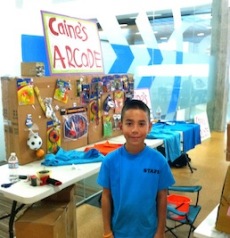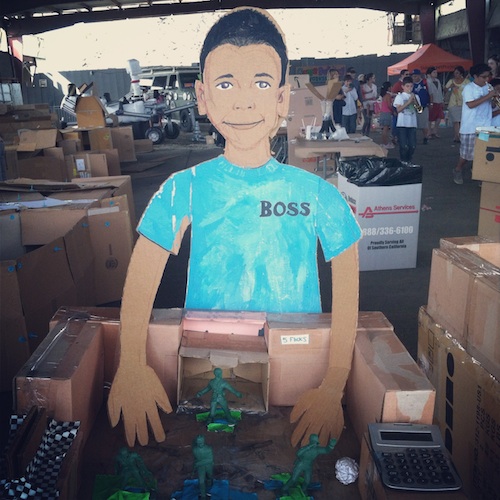 This past fall, I wrote a blog post for the Cooney Center about my experiences at the annual DIY Days conference at UCLA. In that post, I wrote [emphasis added in bold]:
This past fall, I wrote a blog post for the Cooney Center about my experiences at the annual DIY Days conference at UCLA. In that post, I wrote [emphasis added in bold]:
“Many of the people I met are deeply invested in new ways to approach the role of media in children’s learning ecologies. I believe that various projects presented at DIY Days (including R<3S and another very special project I’ll share in a later post) have deep implications for […] problematizing and improving education processes and outcomes in the U.S. and internationally.”
That very special project was Caine’s Arcade.
This morning, I’m beaming because the collective digital bits of the Internet have enabled the rapid spread of the story of Caine’s handcrafted analog world, in the form of a 10-minute movie by producer/director Nirvan Mullick. As I write this, the Caine’s Arcade Scholarship Fund has raised over $70,000 for his college education. I’m sure that before the day is over that number will be much closer, if not have surpassed, the $100,000 target.
Not only did I get to watch an early screening of the short film in October, but I also got to have a bit of the Caine’s Arcade experience. Caine’s fantastic father, George, had temporarily moved most of Caine’s cardboard constructions to the UCLA library and installed them in the lobby for the duration of the day. (Hands down, the best perk of the conference was that all of the attendees got complementary Fun Passes.)
I was so impressed with Caine’s poise and passion, so taken with his father’s devotion and dedication, and so heartbroken at the thought of Caine sitting patiently for customers that never came (except for Nirvan’s serendipitous visit) that I promised to visit Caine’s Arcade in Boyle Heights that weekend.
Having spent some time with Caine and his mentors (and having played his truly amazing cardboard Skee Ball machine), I can tell you that it’s not just the power of a child’s imagination that built Caine’s Arcade. That romantic notion masks the role of the supportive adults in Caine’s life, just as DIY (or Do-It-Yourself) can mask the social and cultural context enabling things to get done only when we Do-It-Ourselves. The overly simplistic view of Caine as a child outside of the adult realm masks the fact that Caine set up in front of his father’s auto parts shop largely because he needed to accompany his father to work on the weekends. There are no playgrounds nearby in the primarily industrial area surrounding Smart Parts Aftermarket in Boyle Heights. Caine’s Arcade exists now in the imagination of millions of people across the world, but no one should forget that it also exists in a very real way at the intersection of three main LA freeways.
Caine’s Arcade is a timely and brilliant example of how our society needs to rethink the ways of doing and thinking that connect children to larger bodies of knowledge and allow them to share their creations with a larger public. A child’s “learning ecology” includes all of the environmental factors, people, and materials that a child learns though across in-school, afterschool, and out-of-school settings. Researchers, designers, and educators in the Digital Media and Learning community are deeply invested in studying children’s learning ecologies, including the folks at the Cooney Center and my collaborators at USC. There is no way that Caine could have developed the skills and experiences he gained through his arcade in his formal education. The passion and interests that drove Caine’s expression and experimentation deserve to be scaffolded and seeded with new informal learning opportunities. These skills and competencies that Caine is developing deserve extra love because they don’t directly translate to any report card, cannot be rewarded by any standardized test, and their impact cannot be measured in an immediately verifiable quantitative way.
At Caine’s Arcade, the value isn’t just in the product, but in the process. Yes, the tickets are redeemable for prizes (I still have the neon green plastic tube bracelet with the glittery water sloshing around inside that I won from Caine. I couldn’t bear to redeem my tickets for one of Caine’s old Hot Wheels car, even if Caine insisted that he’d outgrown them.) But seeing Caine climb inside his machine and hand roll those tickets out to me – that’s priceless. What does have a price tag though is a college degree. You can’t redeem a Fun Pass for a college degree, so I strongly suggest you contribute here.
Meryl Alper is a Ph.D. student in Communication at USC Annenberg. She graduated magna cum laude from Northwestern University in 2005, double majoring in Communication Studies and History. She also holds a certificate in Early Childhood Education from UCLA. Prior to her graduate studies, Meryl interned in the Education & Research Department at Sesame Workshop and worked as Research Manager for the Emmy-nominated Nick Jr. preschool television series “Ni Hao, Kai-lan.” Her main area of research is young children’s evolving relationships with old and new technologies, and in particular, the social, cultural, and historical construction of early literacy, as well as assistive technologies for children with disabilities.
Photo courtesy of Meryl Alper.



